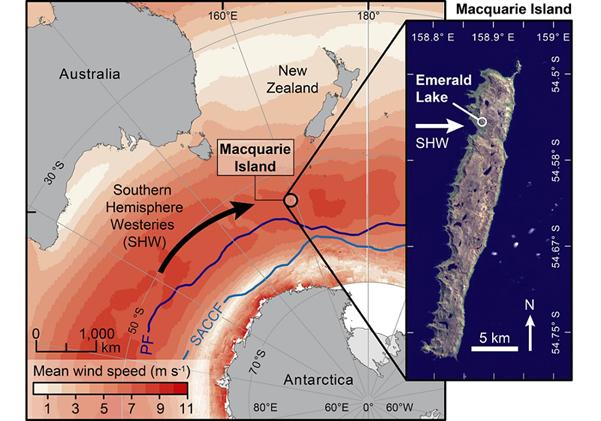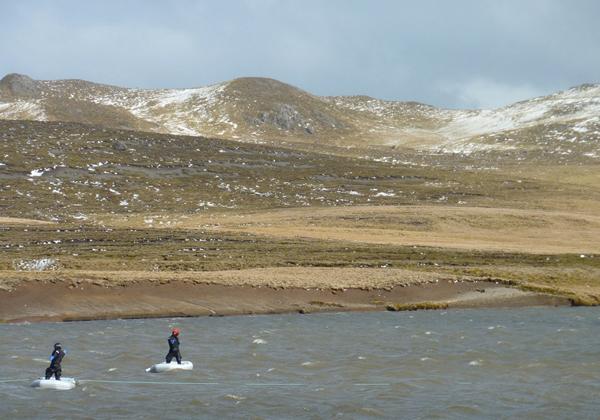

Published on the 6th August 2018 by ANSTO Staff
Strong westerly winds weaken the Southern Ocean’s ability to store carbon and thereby contribute to faster accumulation of carbon dioxide in the atmosphere, according to a new study published today in the prestigious journal Nature Geoscience.
The paper, entitled “Holocene dynamics of the Southern Hemisphere westerly winds and possible links to CO2 outgassing,” was the result of collaboration between researchers from ANSTO, the British Antarctic Survey and the Universities of Bern, Ghent, Aberystwyth and Durham, with logistical support from the Australian Antarctic Division.
ANSTO environmental scientist Dr Krystyna Saunders led the team, which travelled to sub-Antarctic Macquarie Island to reconstruct the behaviour of the Southern Hemisphere westerly winds over the past 12,000 years.
“This is an exciting finding. Our new records of the Southern Hemisphere westerly winds suggest there have been large changes in wind intensity over the past 12,000 years,” said Dr. Saunders.
“This is in marked contrast to climate model simulations that predict only relatively small wind speed changes over the same period.”
The Southern Ocean currently absorbs over 40 per cent of the carbon dioxide produced by human activities, helping to temporarily mitigate the effects of climate change by slowing down the accumulation of greenhouse gases in the atmosphere.
The Southern Hemisphere westerly winds play an important role in regulating the Southern Ocean’s capacity for absorbing carbon dioxide. By regulating sea ice and bringing deep carbon-rich waters up to the surface, strong westerlies limit the extent to which the Southern Ocean can act as a carbon sink.
Previous studies reconstructing the intensity and position of the westerlies were primarily from South America, the only continental landmass that intersects the region where the winds are strongest. However, analyses were hampered by the presence of complex mountain-based effects. Other studies, in locations north or south of the zone of strongest winds, made separating intensity from position complicated.
Travelling to sub-Antarctic Macquarie Island, which lies at a latitude where the winds are strongest, allowed the research team to circumvent these issues and obtain a clearer picture of the westerlies’ behaviour.
To reconstruct the changes in wind speeds over millennia, the researchers analysed lake sediment samples recovered from Emerald Lake. Perched on the western edge of the Macquarie Island plateau, Emerald Lake is directly exposed to westerly air flow and is therefore an ideal place to collect data on the westerlies.
The accumulation of sea spray and wind-blown minerals in the sediment-core samples acted as a tell-tale marker of wind strength, with sections of greater accumulation of wind-blown sea salts and minerals reflecting historical periods of stronger winds.
Radioisotope dating methods were used to date the sediment sequence, while inference models were combined with micro-X-ray-fluorescence core scanning and hyperspectral imaging to determine the sea spray depositions.
By comparing their reconstructed wind intensity data with other climate records, the researchers found that periods of intense wind strength were matched by marked increases in atmospheric carbon dioxide and temperature, as well as declines in sea ice levels.
“The connection between strong and persistent westerlies and rises in carbon dioxide at the beginning of our current warm interglacial period, about 12,000 years ago, and again from about 7,000 years ago, suggests that the winds have determined whether the Southern Ocean acts as a net sink or source of carbon dioxide at different times in the past,” said Dr. Saunders.
“Therefore, over a period of decades to millennia, further increases in wind strength will lead to faster accumulation of carbon dioxide in our atmosphere.”
The full reference is: Krystyna M. Saunders et al. Holocene dynamics of the Southern Hemisphere westerly winds and possible links to CO2 outgassing, Nature Geoscience (2018).
DOI: 10.1038/s41561-018-0186-5
